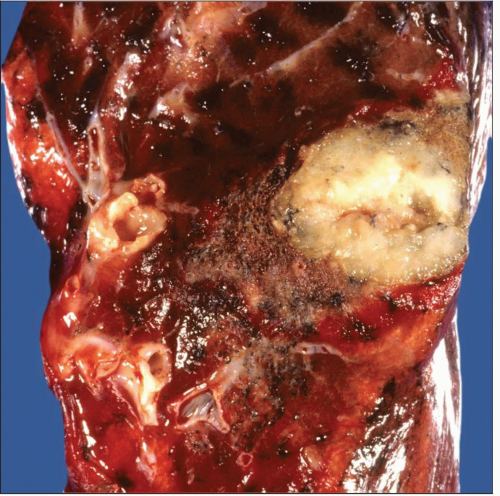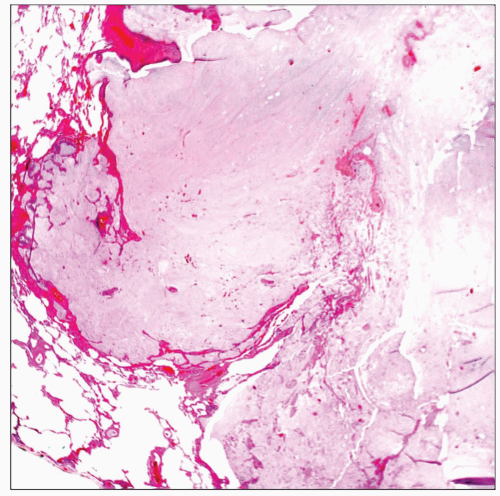Mucinous (“Colloid”) Carcinoma
Key Facts
Terminology
-
Mucinous cystadenoma, mucinous cystic tumor, multilocular cystic carcinoma, mucinous cystic tumor of borderline malignancy
Macroscopic Features
-
Well-defined tumor mass with mucoid consistency, solid &/or cystic
-
Varies from 1 to > 10 cm
Microscopic Pathology
-
Extensive areas of mucinous deposition
-
Alveolar wall lined with mucinous epithelium
-
Single cells or clusters of cells embedded in mucin
Ancillary Tests
-
TTF-1 nuclear positivity (may be negative in some cases)
-
CK7 cytoplasmic positivity
-
CK20 negative (may be positive in some cases)
-
CDX2 negative (may be positive in some cases)
Top Differential Diagnoses
-
Metastatic mucinous carcinoma of extrathoracic origin
-
Clinical history of or clinical evaluation for colonic, ovarian, breast, or urachal carcinoma will be important
-
Immunohistochemical studies important in determining primary site
-
Diagnostic Checklist
-
Extensive mucin
-
Alveolar wall lined with mucinous epithelium
TERMINOLOGY
Synonyms
-
Mucinous cystadenoma, mucinous cystic tumor, multilocular cystic carcinoma, mucinous cystic tumor of borderline malignancy
Definitions
-
Epithelial neoplasm with extensive mucin production
CLINICAL ISSUES
Epidemiology
-
Incidence
-
Pure colloid carcinomas of the lung are rare
-
-
Age
-
Colloid carcinomas are more common in adult patients
-
-
Gender
-
No gender predilection
-
Presentation
-
Cough
-
Chest pain
-
Shortness of breath
-
Asymptomatic
Treatment
-
Surgical approaches
-
Lobectomy
-
Prognosis
-
Depends on staging at time of diagnosis
MACROSCOPIC FEATURES
General Features
-
Well-defined tumor mass
-
Mucoid consistency
-
Cystic changes may be present
Size
-
Varies from 1 to > 10 cm
MICROSCOPIC PATHOLOGY
Histologic Features
-
Extensive areas of mucin deposition
-
Alveolar wall lined with mucinous epithelium
-
Single cells or clusters of cells are seen floating in the mucin
Predominant Pattern/Injury Type
-
Mucinous
Predominant Cell/Compartment Type
-
Epithelial
DIFFERENTIAL DIAGNOSIS
Metastatic Mucinous Carcinoma of Extrathoracic Origin
-
Clinical history of or clinical evaluation for colonic, ovarian, breast, or urachal carcinoma will be important
-
Immunohistochemical studies important in determining primary site
Bronchioloalveolar Carcinoma (BAC), Mucinous Variant
-
In BAC, lepidic growth pattern is characteristic feature in which alveolar lining is substituted by mucinous type of epithelium
-
BAC commonly will diffusely involve the entire lung or extensive areas of it
-
Immunohistochemical features of BAC and colloid carcinoma may be similar
DIAGNOSTIC CHECKLIST
Clinically Relevant Pathologic Features
-
Gross appearance
Pathologic Interpretation Pearls
-
Extensive mucin
-
Alveolar wall lined with mucinous epithelium
GRADING
Colloid Carcinoma
-
Considered low-grade malignant neoplasm
-
Behavior determined by pathological staging at time of diagnosis
SELECTED REFERENCES
1. Bacha D et al: A pulmonary mucinous cystic tumour of borderline malignancy. Pathologica. 100(3):189-91, 2008
2. Maeda R et al: Primary pulmonary mucinous (colloid) adenocarcinoma. Gen Thorac Cardiovasc Surg. 56(4):195-8, 2008
3. Moran CA: Pulmonary adenocarcinoma: the expanding spectrum of histologic variants. Arch Pathol Lab Med. 130(7):958-62, 2006
4. Türüt H et al: Primary pulmonary mucinous adenocarcinoma in a 15-year-old boy. Eur J Cardiothorac Surg. 29(5):851-3, 2006
5. Brownlee NA et al: Mucinous (colloid) adenocarcinoma of the lung. Arch Pathol Lab Med. 129(1):121-2, 2005
6. Okimasa S et al: Mucinous (colloid) adenocarcinoma. Jpn J Thorac Cardiovasc Surg. 53(6):305-8, 2005
7. Jayaram G et al: Mucinous carcinoma (colloid carcinoma) of the lung diagnosed by fine needle aspiration cytology: a case report. Malays J Pathol. 25(1):63-8, 2003
8. Moran CA. Mucin-rich tumors of the lung. Adv Anat Pathol. 2(5):299-305, 1995
9. Moran CA et al: Mucinous (so-called colloid) carcinomas of lung. Mod Pathol. 5(6):634-8, 1992
10. Graeme-Cook F et al: Pulmonary mucinous cystic tumors of borderline malignancy. Hum Pathol. 22(2):185-90, 1991
Tables
|
Immunohistochemistry
Stay updated, free articles. Join our Telegram channel
Full access? Get Clinical Tree
 Get Clinical Tree app for offline access
Get Clinical Tree app for offline access

|
|---|

